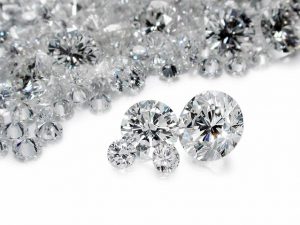Maybe. Maybe Not. Sadly, the Industry Can’t Tell You.

When the 709-carat “Peace Diamond” from Sierra Leone was sold at an auction last December, its marketers and sellers promised the proceeds of the diamond would help bring development and peace to a region still beset by many challenges since its devastating war came to an end 15 years ago. Whether or not the $6.5 million selling price will bring such benefits remains to be seen, but the specificity and transparency about the proceeds from the sale of this diamond is inherently a positive step. Positive because the buyers of the jewelry born of this remarkable stone will know the story of where it came from, and be confident that their purchase likely helped support the people there.
As millions open their Valentine’s Day gifts, they may wonder the same thing: do I know the story of this diamond, and can I be confident that it helped the people of the country where it was mined.
Sadly, in just about every case, the answer is no. Or maybe not. But it could — and should — be otherwise.
When an initiative called the Kimberley Process (KP) came into effect in 2003, the expectation was that it would be otherwise. Brought into being largely because of the worldwide campaign against “blood diamonds,” the KP was created to provide assurance that diamonds do not fund conflict. The idea was simple: certificates are issued by an exporting government to assure an importing government that rough diamonds have not been used by a rebel movement in an effort to overthrow a legitimate government.
While the KP has brought about many positives, it has failed in two key ways. First, even though only a small share of the world’s rough diamonds is officially designated by the KP’s narrow definition as “conflict diamonds,” the KP has nonetheless not been able to stop even those from being exported and traded.
Second, even though governments and industry from across the globe come together bi-annually and are willing to discuss the problem of armed groups linked to the diamond trade, they have not directly addressed issues such as forced/child labor, environmental concerns, money laundering, or sustainable development. The things that many consumers, especially millennial consumers, care about the most.
But even if you take the KP at its first goal — stopping diamonds sold by rebel movements — it has largely failed. The KP says 99+% of diamonds are now conflict-free, but unfortunately that is only because “conflict-free” is so narrowly defined. In fact, within the KP’s definition, there is only one, partial, case of conflict diamonds in the world today, in the Central African Republic (CAR). Despite what you’re likely to hear from the salesperson behind the jewelry counter, the real world belies the KP’s glowing statistics.
As the European Union takes over the KP and identifies new areas for progress for the initiative, an array of disturbing facts about CAR makes plain that conflict-affected diamonds continue to be produced and enter global markets:
- In CAR alone, hundreds of thousands of carats are unaccounted for. Current official diamond exports for CAR total approximately 56,000 carats, while geological estimates and previous KP production data show that the country typically produces more than 300,000 carats per year from thousands of individual sites, a damning disparity.
- UN and other observers have raised concerns with continued illegal exports from areas considered “KP compliant zones.”
- There are more than 20 armed groups across CAR, many active in mining zones and involved in trading diamonds, according to evidence gathered by the United Nations and other concerned organizations including our own investigative initiative, The Sentry.
- These armed groups are connected to brutal violence across the country, particularly in the east, where a rebellion-turned-coup began in late 2012 and where, in recent months, bloody battles for territorial control between them have been spreading.
- Rule of law across CAR is minimal, as the CAR government has extremely limited presence beyond the capital city of Bangui.
- Despite its natural resource wealth, large portions of the population do not have access to basic services, and the country ranks at the bottom of most indices of development.
- The UN and other observers have shown that conflict diamonds smuggled from CAR have been laundered in the certified diamond chain via Cameroon, the Democratic Republic of Congo, and ultimately the United Arab Emirates (UAE).
Does that sound like the meaning or spirit of “conflict-free”?
If not, as you think about your next jewelry purchase, ask the salesperson how they know the diamond they’re selling didn’t come from conflict sources in CAR. When you inquire whether a diamond is conflict-free, you will likely receive a series of smooth platitudes and generalities. Worse, they expect to get away with it. Because right now much of the diamond industry – as well as many governments involved in the KP – think that you as consumers are more focused on things like whether the diamond is synthetic or natural.
In fact, the industry is spending tens of millions of dollars campaigning to tell you that “real is rare,” and recently an industry leader complained that millennials were being “lied to” about synthetics. Yet at the same time, the industry fails to take meaningful steps to do what is needed to promote better practices within the supply chain. In fact, this industry leader works with a company that has itself reportedly been connected to the illicit diamond trade in CAR.
It’s time to tell leaders like this that you do want the truth. And that you want real to not just mean rare, but also to mean responsible.
Under the current status quo, the Peace Diamond is a hopeful symbol of what the industry and KP could do if they took full ownership of due diligence and development responsibilities.
That should be the story every diamond can tell.

